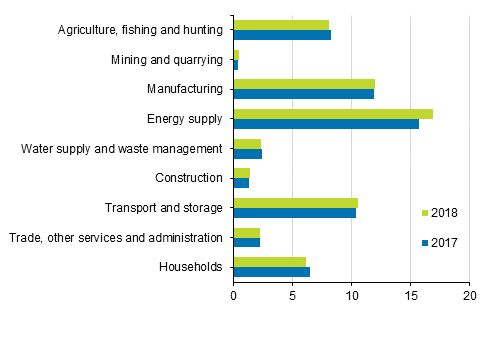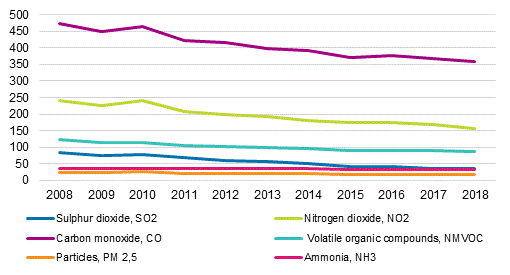Published: 1 October 2020
Greenhouse gas emissions in Finland grew in 2018 – emissions of pollutants continued declining
Greenhouse gas emissions produced by Finnish residents rose in 2018. At the same time, emissions of air pollutants decreased. Greenhouse gas emissions in Finland and abroad amounted to 60 million tonnes, which was almost two per cent more than in the previous year. The most significant contributor to the growth was the eight per cent increase in emissions from energy production compared with 2017. Carbon dioxide emissions from biomass, which are not counted as greenhouse gas emissions, grew by three per cent and amounted to 42 million tonnes. Of the emissions of air pollutants, nitrogen dioxide emissions decreased most, by seven per cent, and sulphur dioxide emissions, by six per cent.
Greenhouse gas emissions by industry in 2017 and 2018, million tonnes CO2 equivalent

Emissions from manufacturing and trade remained almost on level with the previous year. The growth in greenhouse gas emissions was mostly due to increased emissions from energy supply. Greenhouse gas emissions from energy supply increased by eight per cent from 2017 as production of condensate electricity increased. Energy supply’s annual emission volumes vary considerably especially on account of electricity imports and production of fossil condensate energy, whose volumes are, in turn, dependent on the availability of hydro power on the Nordic electricity market.
Greenhouse gas emissions from construction also grew by nearly nine per cent from the previous year. By contrast, emissions from both heating and transport among households decreased. Emissions from heating of buildings fell by seven per cent because the weather was warmer than in the previous year and the need for energy was thus lower. By contrast, emissions from households' transport decreased by four per cent as a result of reduced consumption of petrol and increased share of alternative motive power.
In transportation and storage, emissions grew by one per cent from 2017. Greenhouse gas emissions from land transport increased by five per cent from the previous year as the use of diesel increased and the biofuel shares of transport fuels fell.
Emissions of pollutants in 2008 to 2018, thousand tonnes

At the same time, emissions into air not included in greenhouse gases decreased compared to 2017. Nitrogen oxide emissions, which were seven per cent down on the previous year's level, and sulphur dioxide emissions, which went down by six per cent from the year before, decreased most. This development was mostly affected by a seven per cent drop in sulphur dioxide emissions in energy supply and a decrease in nitrogen oxide emissions in land and water transport. Carbon dioxide emissions from biomass generated by households' transport fell by five per cent as a result of decreases in the biofuel share of liquid fuels.
Emissions of carbon monoxide and non-methane volatile organic compounds (NMVOC) also decreased by three per cent from the previous year. Carbon monoxide emissions are mostly generated from households' burning of wood and transport. Large amounts of NMVOC emissions are generated in agriculture and households’ burning of wood. Fine particulate matter emissions have decreased by one per cent from the previous year. Particulate matter emissions have decreased particularly in energy supply and transport.
Emissions into air by industry groups 2018, tonnes
| Greenhouse gases (CO2-foss, CH4, N2O, HFC, PFC, SF6) CO2-eq. | Carbon dioxide emissions from biomass (CO2-bio) | Particles, < 2,5 m (PM 2,5) | Carbon monoxide (CO) | Nitrogen dioxide (NO2) | |
| Agriculture, forestry and fishing | 8 125 541 | 807 828 | 999 | 14 169 | 6 529 |
| Mining and quarrying | 478 298 | 464 | 1 301 | 2 001 | 1 779 |
| Forest industry | 2 927 592 | 20 667 695 | 1 514 | 25 599 | 18 986 |
| Oil refining and manufacture of chemicals | 3 794 936 | 172 223 | 345 | 1 005 | 3 329 |
| Manufacture of basic metals and fabricated metal products | 3 539 850 | 6 078 | 403 | 1 627 | 3 103 |
| Other industries | 1 683 362 | 148 794 | 503 | 5 085 | 2 798 |
| Energy management | 16 904 557 | 12 289 835 | 373 | 15 283 | 26 834 |
| Water supply and waste management | 2 370 733 | 316 374 | 22 | 255 | 973 |
| Construction | 1 458 205 | 70 168 | 462 | 6 463 | 6 838 |
| Trade | 500 504 | 66 107 | 49 | 197 | 293 |
| Land transport | 4 195 317 | 503 888 | 943 | 3 414 | 16 366 |
| Water transport | 2 403 230 | 5 730 | 429 | 4 545 | 35 583 |
| Air transport | 3 637 222 | 23 369 | 185 | 5 412 | 13 670 |
| Other service activities and administration | 2 093 291 | 401 622 | 574 | 25 237 | 6 324 |
| Households | 6 183 802 | 6 184 341 | 10 181 | 247 696 | 14 617 |
| TOTAL | 60 296 440 | 41 664 516 | 18 283 | 357 988 | 158 022 |
The statistics on emissions into air by industry are calculated according to the EU Regulation on environmental accounts. The industrial classification and division used in the statistics differ from the sector division used in the reporting of the greenhouse gas emissions to the UNFCCC. The statistics do not take into consideration the amount of carbon dioxide absorbed by forest or other vegetation either.
Differing from the greenhouse gas inventory and greenhouse gas reporting, the statistics on emissions into air by industry also contain Finnish residents' emissions from land, water and air transport abroad. In turn, emissions by foreign citizens from transport on Finnish territory are subtracted from the emissions into air by industry. Due to definitional differences, the total volume of greenhouse gas emissions by industry is higher than in the Greenhouse Gas Inventory reported to the UNFCCC.
Source: Emissions into air by industry 2018, Statistics Finland
Inquiries: Juuso Peltola 029 551 2330, Kai Skoglund 029 551 2675, ymparistotilinpito@stat.fi
Head of Department in charge: Mari Ylä-Jarkko
Publication in pdf-format (183.8 kB)
- Tables
-
Tables in databases
Pick the data you need into tables, view the data as graphs, or download the data for your use.
Updated 1.10.2020
Official Statistics of Finland (OSF):
Emissions into air by industry [e-publication].
ISSN=2323-7600. 2018. Helsinki: Statistics Finland [referred: 24.12.2025].
Access method: http://stat.fi/til/tilma/2018/tilma_2018_2020-10-01_tie_001_en.html

